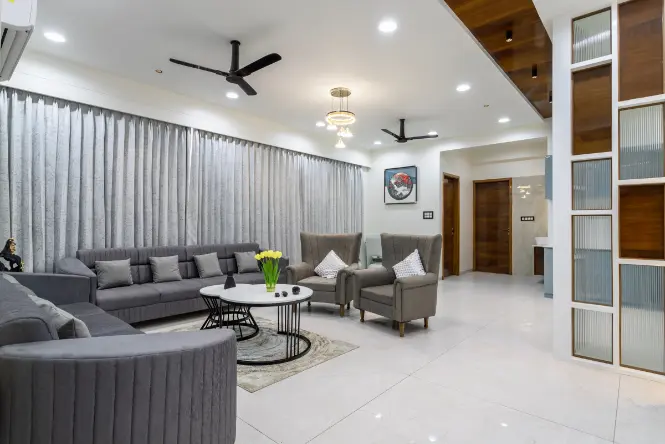The Importance of Texture in Home Interior Design
The Importance of Texture in Home Interior Design
Blog Article
The texture is a basic part of home interior design that is sometimes ignored, but it plays a crucial role in creating a specific ambiance in a home. It is the quality of a texture, whole qualities like roughness, smoothness, softness, hardness, glossiness, or matte finish.

For home interior designers in Ahmedabad, the texture is not just a design element but a vital idea that increases how we feel and builds an experience that works beyond imagination. By skillfully incorporating different textures, designers can create contrast and balance, enhancing the overall aesthetic and functionality of a space.
WHY IS TEXTURE IMPORTANT IN HOME INTERIOR DESIGN?
Texture plays an important role in home interior design. It influences the mood, atmosphere of a space, and our emotional response. Additionally, texture can visually alter the perceived size of a room, making it appear larger or smaller.
Here are 3 significant ways that texture contributes to home interior design:
1. Texture Provides Visual Interest
Texture is a fundamental element in home interior design. It significantly impacts the visual of a space. Rough textures create a sense of solidity and groundedness, while smooth surfaces evoke a lighter, airier feel. Home interior Designers can strategically utilize this principle to balance proportions and achieve a harmonious aesthetic. For example, delicate, smooth throw pillows can offset the substantial weight of a heavily textured sofa.
2. Texture Provides Balancing the Space
In-home interior design, balance is key. Texture helps achieve these home design elements such as colour, pattern, and looks. Also, Texture can immediately change the size and look of a room. Smooth, reflective textures like glass and metal can make a small room appear larger, while rough, matte textures can create a more intimate and cozy atmosphere.
3. Texture Provides Comfort and Warmth
Texture is a powerful element in home interior design, contributing depth, comfort, and visual interest to any space. Soft fabrics like velvet or wool create cosy environments, while rough materials like wood or stone provide a grounding effect. A home interior designer plays a crucial role in integrating these textures to craft spaces that offer both comfort and warmth. Through their home interior design service, they utilize textured fabrics, soft rugs, and layered furnishings to add depth and personality. By incorporating these elements, a home interior designer transforms any space into a welcoming haven, enhancing its aesthetics and comfort.

Two Types of Texture in Home Interior Design
Texture in home interior design can be categorised into two main types: tactile and visual.
1. Tactile Texture
Tactile texture refers to the physical variations on the surface of a material that can be both seen and felt. This type of texture is characterised by its three-dimensional qualities, allowing us to experience the smoothness or roughness of a material through touch. For instance, the grain of wood, the coarseness of jute, and the softness of fur all embody tactile textures.
Examples like satin curtains, furry carpets, and fuzzy couches showcase these tactile qualities, offering a distinct sensory experience through their height, width, and depth.
2. Visual Texture
Visual texture is essentially an illusion, representing the appearance of a surface without any actual physical texture. In interior design, this type of texture creates the impression of depth, visual interest, or style, even though it cannot be touched. For instance, wallpaper with a specific pattern or a piece with a marbled finish demonstrates visual texture, which pertains to two-dimensional characteristics.
Examples of objects with visual textures include images in a mirror, terrazzo tiles, and photographs. Additionally, some surfaces, like laminates, mimic textures like wood but remain smooth to the touch, further illustrating this concept.
3 Ways to Add Texture to Any Room in Home Interior Design
As trends in home interior design in Ahmedabad evolve, so do the innovative ways textures are used to create stunning interiors. Here are three of the latest trends:
1. Go Organic
Natural elements like stone, wood, and jute introduce organic textures that connect warmth and depth into a space. Materials such as wood, textiles, and stones offer a broad spectrum of textural possibilities. In their rugged forms, they can bring a rustic charm to your interiors. Even the colour accents are often in earth tones that seamlessly blend into the design.
2. Focus on Architectural Elements
Architectural elements like exposed brick walls, wooden beams, or tiled floors bring textures to a room. Enhance architectural elements like wall panelling, trim, and mouldings with texture for added depth in your home. In kitchens, studies, and bedrooms, abstract texture walls or 3D panelling create a dramatic effect, with strategic lighting and colour maximising the impact.
3. Decorate with plants, flowers, and lighting.
The plants and flowers can be touched, and their impact is more about visual texture. Variations in form, petal and leaf shapes, height, colour, and containers all contribute to a room’s texture. Lighting also contributes to texture in two ways: the design of the lamp itself and the quality of light it emits. Warm white light (around 300 kelvins) creates a softer, more ambient glow, while cool white light (about 500 kelvins) offers a brighter, more contemporary beam, which can make a room feel harsher.

Conclusion
Ready to use more texture in your home? Connect with JDesign Studio, the best home interior designer in Ahmedabad, to start designing a space that engages all your senses. Visit our website, or call us at +91 84690 01783 to book a consultation with our interior designers. Let’s bring your vision to life with the perfect blend of colours, patterns, and textures. Don’t be worried about using various materials and textures; this can add depth and character to any room.